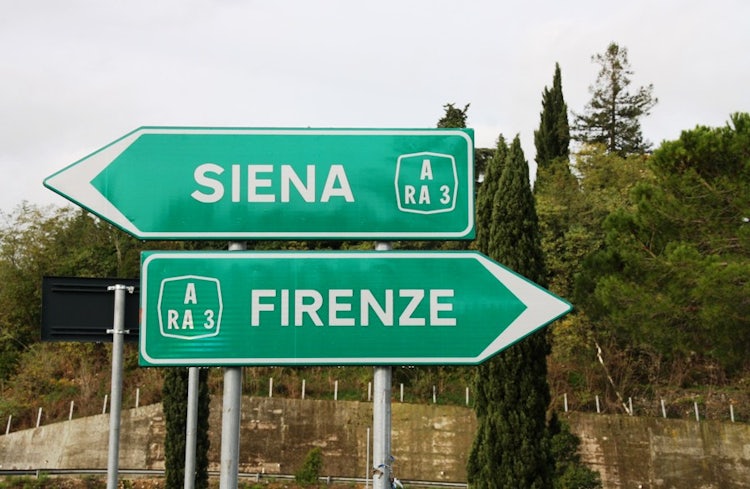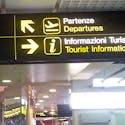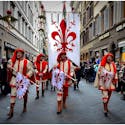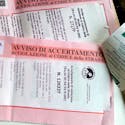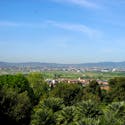What you need to know about driving in Tuscany (and Italy) that might be different from back home
Exploring Tuscany with your own means of transportation gives you maximum flexibility and there are many areas in Tuscany where a car is really the only option as buses and trains are not available.
Given lots of feedback and questions on our forum and other articles, we want to make sure we highlight some of the things you should know before you get driving in Tuscany (applicable to other parts of Italy, of course).
Busy commuting hours
The main roads are good but can get quite busy as locals go about their daily lives. In particular, there is a lot of traffic around Florence, on the autostrade and superstrada between Florence and Siena (called that, "superstrada Firenze-Siena) can be intense at times as they are used by commuters getting to work in Florence and back home in the afternoons/evenings. If you can, try to avoid driving into or out of Florence around the start of the working day and end (this is usually around 7-9am and 5-7pm).
Driving in Tuscany in fall and winter
Make note of this important detail regarding driving between November 1st - April 30th in Tuscany: you are REQUIRED by LAW to carry snow chains or have snow tires on your car. If you're renting a car during this period, make sure to ask that your car is outfitted with snow tires or there are chains in the boot, with instructions on how to mount them, should you need them.
Autostrade are toll roads
All the roads marked as autostrade in Italy are toll roads, the ones with an "A" in front with a number after, but there aren't that many in Tuscany. The backbone of the Italian motorway system, the A1 (Autostrada del Sole) goes from Bologna through northern Tuscany, swings around Florence and heads southeast towards Arezzo and Cortona before continuing on to Rome.
Off the A1, the Autostrada Firenze Mare/A11 motorway connects Florence to Lucca/Pisa and the Autostrada A12 motorway moves along the seacoast from Genoa and La Spezia south through Viareggio, Pisa and Livorno. The road continues all the way to Rome but at Rosignano Marittimo, south of Livorno, the roadway ends as a toll road (so you pay the toll fee there) and the road continues along what is called the "Via Aurelia" which isn't a toll road (it might eventually become one).

[Click on image for wider view]
There are also toll-free roads
A couple of four-lane, toll free roads do exist as alternatives to the autostrade. For example, the SS1 (Via Aurelia) along the coast is four lanes almost all the way from Livorno Sud (south) down to Tuscany's southern border with Lazio.
The SGC highway (known as the Fi-Pi-Li) connects Florence, Pisa and Livorno.
The Firenze-Siena, which starts near the A1 "Firenze-Impruneta" entrance/exit, is a toll free, 4 lane road that links Florence and Siena. It almost runs parallel to the SS2, also called La Cassia or Senese, which is an ancient road that links Florence and Siena (and continues on to Rome - don't worry, it is a paved road, has been for some time ;) ). As a two-lane road, the Via Cassia passes through many hill towns on the western edge of the main Chianti area, so expect a winding road that goes up and down through beautiful landscapes. The Firenze-Siena skips most of these small towns, making it convenient when you are interested in reaching the same parts of Tuscany a little faster or to get to Siena and beyond a bit quicker. But if you're looking for a scenic drive, do take the Cassia road!
Away from the main centers, the smaller roads frequently offer pretty drives - but be prepared to take your time. Progress around Tuscany's winding roads can be slow as well as very beautiful!
For traffic information, you can call CIS Viaggiare Informati at 1518, a number active 24 hours a day.
Let's do a quick recap of the main roads and motorways in Tuscany:
| Main Roads in Tuscany | from - to |
| SGC Firenze-Pisa-Livorno (dual carriageway) | Motorways A1 A11 A12, Firenze, Empoli, Siena, Pontedera, Valdera, Livorno |
| SS 1 Aurelia (state road) | Rome, Grosseto, Livorno, Viareggio, Versilia, Massa, Carrara, La Spezia, Genoa, Motorway A11 |
| SS 12 dell'Abetone e del Brennero (state road) | Lucca, Garfagnana, Abetone, Modena |
| SS 224 (state road) | Marina di Pisa, Tirrenia, Valdera, Porto di Livorno |
| SS 67 (state road) | Florence, Empoli, Siena, San Miniato, Pontedera, Valdera, Volterra |
| SS 206 (state road) | Cecina, Castagneto Carducci, San Vincenzo |
| SS 2 (state road) | Florence, Poggibonsi, Siena |
| Main Motorways | from - to |
| A12 (toll road) | Rosignano, La Spezia, Parma, Genoa |
| A11 (toll road) | Bologna and Rome (A1 motorway), Firenze, Prato, Pistoia, Montecatini, Lucca |
| A1 (toll road) | Bologna, Florence, Siena, Arezzo, Cortona |
Basic Road Rules: Speed Limits
I guess since most of my driving experience is now in Italy, I sometimes forget to emphasize some basic rules that everyone here has to learn when taking their driving test and that become second nature.... and that obviously tourists might not know!
The most important are regarding speed limits. Driving back in the US, I realized recently that there are LOTS of signs reminding people of the speed limit, while Italy doesn't have that many although they are used when the limits change (entering and exiting towns along regional roads). It can definitely be one way to "trap" the unsuspecting tourist, but I don't think that is the reason why there are less signs. It is just that there are a few "speed limits" based on type of road and they apply everywhere, so even if you don't see a sign, you know more or less what the speed limit is without needing a reminder.
The speed limits are these:
- In towns, along all streets: the speed limit is always 50 km/hr. If you are near a school, there are NO SIGNS telling you to slow down because there are children near by, you should just slow down automatically if you see children! Also, some streets are NARROW and you cannot go down them at 50 km/hr, so go slower at what feels a safe speed. Traffic will also make you go slower. Essentially, you never are wrong if you go slower than 50 in any town but, as you drive across Tuscany and cross small villages, you will see a sign at the start of these small villages (even when they are just a few houses) that remind you the speed limit is 50, and a sign at the end that the speed limit has ended, like the sign below:
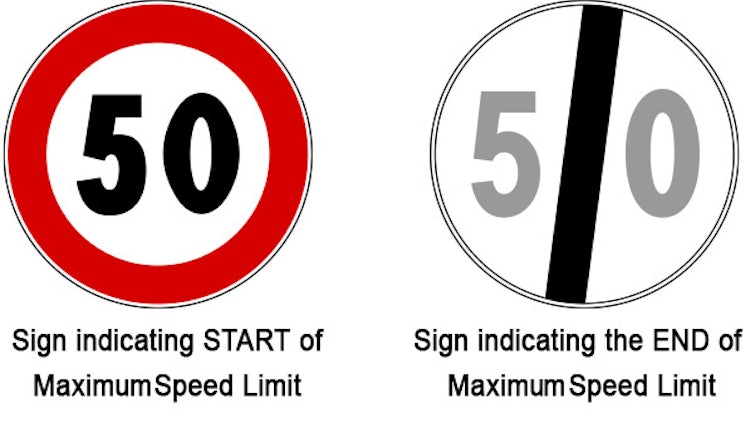
- As you leave town, the speed limit rises to 70 km/hron seconday roads and signs can indicate that speed can be up to 90 km/hr. This is not that common in Tuscany, since 90 is more for straight roads. The Firenze-Siena superstrada is a 90 km/hr road, even if you see people going faster! The Fi-Pi-Li is another road whose speed limit is 90 km/hr but most 2 lane roads at most will be 70.
- Autostrade: the speed limit can vary from 110 to 130 km/hr. The most common is 130, but signs will be posted when the speed limit falls. Pay attention, don't always follow the speed of traffic.
Use of headlights in the day
Even if it is day, as soon as you leave the city, all cars and motorcycles need to use headlights. So turn them on!
Get that GPS!
It will be easier to get around everywhere with a GPS system, so either rent one with your car or download some maps on your phone (to be able to use them offline with no data plan usage) and make sure to let them guide you. They will be lifesavers when you miss exits and can re-route you in rather than try to make U-turns and go back.
A good reason to also get one is that they generally will signal a speed control camera coming up (read more below on that).
Make a solid mental note of this: they do NOT tell you are entering a dreaded ZTL area (more below). So pay attention to signs if you've arrived into a town and are looking for parking, not your GPS.
City Driving: parking and avoiding the ZTL!
In general, in most cities (such as Florence and Siena) you should park your car and forget about driving it in town. Just walk everywhere!
Driving in the historical center of most towns is either banned or restricted and finding a legal parking spot can be a nightmare. Until you know your way around, park in a designated metered parking area or parking lot/garage. You will find these by following solid blue signs with a large capital white "P". If you leave the car away from the center, you can often even find free street parking. Read more about the ZTL in Florence here and where to park in Florence and where to park in Siena. In smaller towns, avoid them by following the "P" parking signs as soon as you arrive at your destination instead of going into the town, as you might end up inside the ZTL by following other cars (locals who live in town will have permits and can go there). These zones are well-marked but easier to see as you walk into the town as opposed as driving.
Signs are white with a white circle with red border, with a blank in the middle, with "Zona Traffico Limitato" usually spelled out.
At parking spaces outside the ZTL, make sure to pay at a nearby machine for the time you want. A slip will be made out, this has to be placed on your car's dashboard. Try to respect that time, as exceeding it can result in a parking ticket.
When you do drive around in cities such as Florence, it will be a bit chaotic and unnerving initially. Road rules and traffic lights are generally respected, but many drivers will drive very close to you (not respecting safe stopping distances) and many double park (as a way to resolve the problem of looking for and not finding a parking spot). So have a lot of patience and you will survive ;-).
Never leave anything valuable in your parked vehicle. When possible, do not leave anything in the car AT ALL because the sight of suitcases or bags invites thieves to help themselves. This is particularly true in Pisa, where many believe they can make a quick stop at the Leaning Tower of Pisa right before or after the Pisa airport, with a car load of suitcases. Cars get broken in daily in Pisa to steal suitcases!!
If you're planning on renting a car in Florence, I recommend NOT having a car while you're in Florence and only renting once you're planning to leave the city. One sure way to avoid all headaches with the ZTL is to rent from the airport: take a taxi or the bus shuttle to the airport to pick it up.
Roundabouts galore!

Across all of Europe, roundabouts (also known as traffic circles or rotundas) are very common. They are a way to manage intersections that work better than stoplights - if people knew how to use them!! And I have to say most Italians might know how to use them but don't care to follow the rules and don't give the right of way when they should.
If you're not used to roundabouts, know that cars already on the roundabout generally have the right of way, but this is not always the case. Pay attention to local example and to signs (as local example can be quite chaotic). The sign to the left indicates a roundabout, the invereted triangle on the top means you have to give the right of way.
If you're not familiar with roundabouts, they can be intimidating. You're supposed to slow down and stop to give right of way to those already inside. If you're waiting to enter a roundabout and cars come barrelling fast from another entrance into the roundabout, going right into the roundabout without slowing down or giving the right of way, inch your way into the roundabout and make them slow down, otherwise you might be there for a LONG time!
As you come into the circle, keep an eye out for which road you need to turn off of the circle and continue to your destination (another great reason to have a GPS). If you miss your turn, don’t panic since you can keep going around until you get it right!
Speed control: check your speed and don't try to "keep up with traffic"
This is a very important one. You will right away notice that Italians like to go fast. They are also quite aggressive drivers. If you're not an aggressive driver, driving in Italy will be stressful. Get someone else to drive! I am not joking, you will enjoy your time in Italy better if you're not driving.
The important thing to note here is that even if they drive fast, Italians have developed good reactive skills and generally can react and stop quickly. But do not tempt them if you're not sure of what you're doing. You will need to be assertive in your driving if you want to drive fast, too.
Having said this, there are SPEED CAMERA CONTROLS everywhere to try to get Italians to respect the law and to get them to slow down.
Guess what? Most GPS systems alert drivers that there are speed controls coming up -- and there are also signs that warn you there is one coming up, which say "controllo elettronico della velocita" and look look like this:
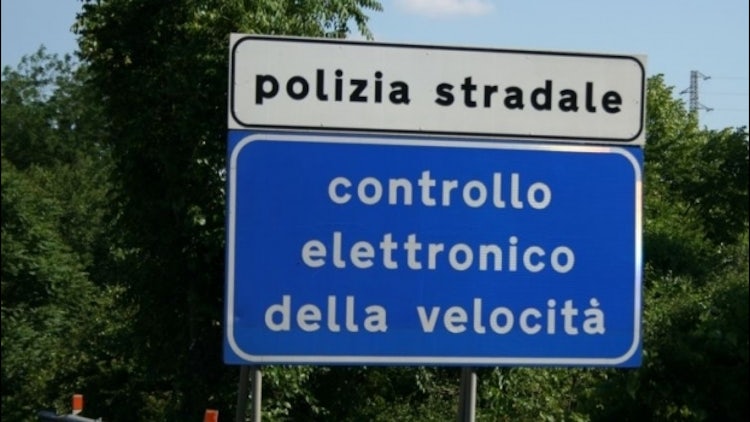
They say that the street is patrolled by electronic means.... and generally, shortly thereafter, there is this sign RIGHT ABOVE the speed control camera tower that will take a photo of your car and its license plate!
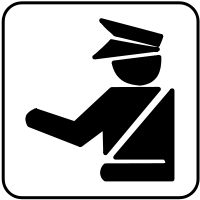
Make note of that again: the sign is right above the speed control camera tower, you will see other cars hit their brakes right around that tower and you should do likewise if you were going with the flow and over the speed limit. Unless you want a speeding ticket souvenir once you're back home.... these automatic cameras take photos of your car (or rental car, whatever the case might be) and it might take months for the ticket to get to you as they track you down, but you WILL be tracked down. These speed controls are not just for tourists, they are for everyone! The main difference is that you likely weren't expecting it, while locals do know about them and know where they are if they are commuters or go down that road often.
You don’t have to be going a certain amount over the posted limit to be in violation. A few km over the posted limit will get you a ticket.
Having said this, I'd suggest to not try to "keep up with traffic" as you drive around Italy.
Why? Because most of the major highways, the autostrade, have a Tutor System that will snap a photo of every car that passes the first camera (usually fixed on an overpass). Then about 10-20 kilometers later it snaps another photo again. The speed of the vehicles is then averaged, and if your average speed is over the limit, you're getting a ticket along with everyone else. I've seen this on autostrade to the north of Tuscany, maybe not yet installed all over Tuscany yet but it doesn't mean they might not appear in Tuscany soon.
Know some basic road signs
As part of your planning for driving in Tuscany, should document yourself on some basic traffic and road signs. Travel guides will have more detailed info, but here are some of the basic ones.
- Blue signs indicate main roads and show the direction you want to travel.
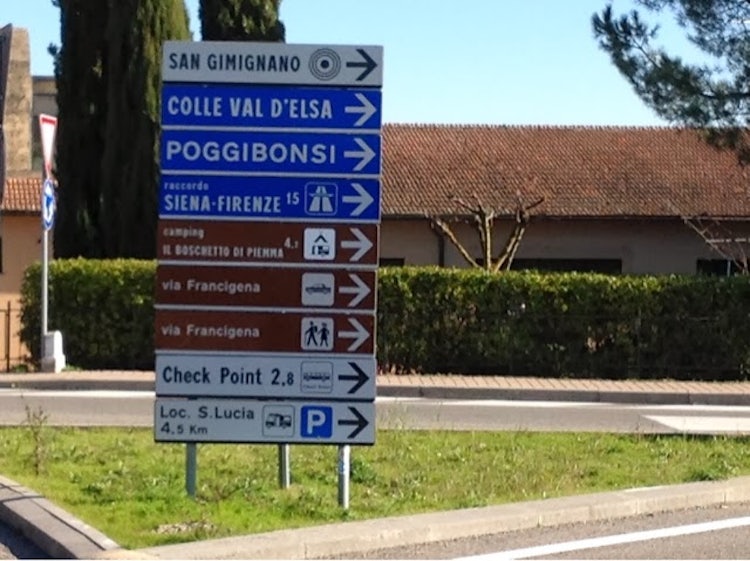
- Green signs indicate the Autostrade, which is you remember from above, are usually toll roads. Not the Firenze-Siena road, but that is also considered a major road so signs have changed recently to green (they were blue a few years ago).
- NO PARKING signs are blue circles with a red border and red diagonal slash through the center. This one indicates your car will be towed if you park there.
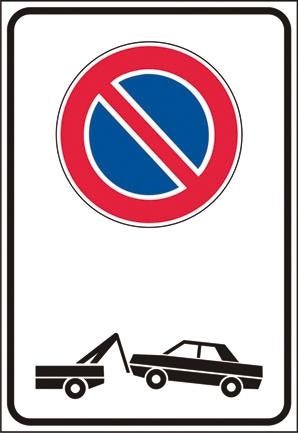
- NO STOPPING signs are blue circles with a red border and have a red X (instead of a single slash) so don't park or STOP here either, even if you remain inside the car! The NO SOSTA sign (below the first sign) is also a "no stopping" sign, but in this case it is to warn you against temporary parking.
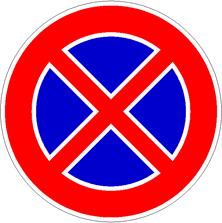
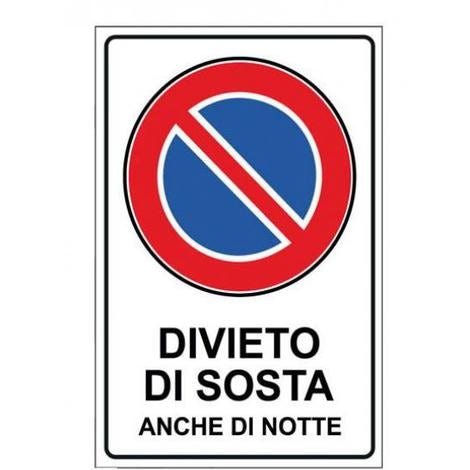
- Parking spaces where you can park are designated with a large capital white P on a solid blue background, usually a square sign.

Gasoline
Gasoline (benzina) in Italy is among the most expensive in Europe. Prices have been around € 1,70/liter for unleaded (senza piombo) gasoline (about $9 per gallon)! Stations along the autostrade generally cost up to 10 cents more per liter.
Gas stations on the autostrade are open 24 hours a day. Otherwise, hours tend to be from 7.00 am to 12.30 pm and from 3.30 to 7.00 pm. Many are closed on Sundays and holidays, and those that open then are then closed on Mondays.
Don't assume you can't fuel up if the station is closed; if you can drive in into the station, it means they likely have self-service pumps that accepts bank notes so you can fuel up anyway or debit/credit cards so that you can pay and pump gas yourself.
Breakdown, Accident or Emergency
As a rule, holders of auto insurance with foreign organizations such as AAA (USA), AA (UK) or RAC will be provided with an emergency assistance number while travelling in Italy. You can also call the Automobile Club d'Italia (ACI) for roadside assistance and a tow by calling 116. If you have the appropriate insurance, you should be covered. It is likely in any case that an ACI truck will show up regardless of the number you use.
For more serious trouble, call the Police at 113, Fire department at 115 or Ambulance at 118.
Rental companies
All the big companies have offices in the main cities and airports in Tuscany, including Avis, Hertz, Europcar and Maggiore/National and Sixt. Search for the best deal for your car rental in the search box below and don't forget to read our tips regarding car rental here.
If you have any further questions, post on our forum.
Enjoy driving in Tuscany!
